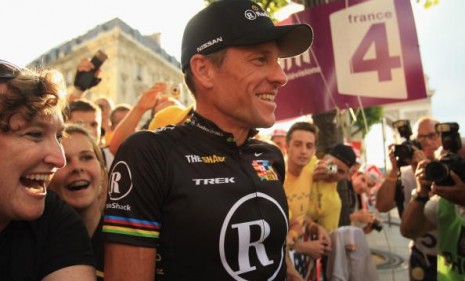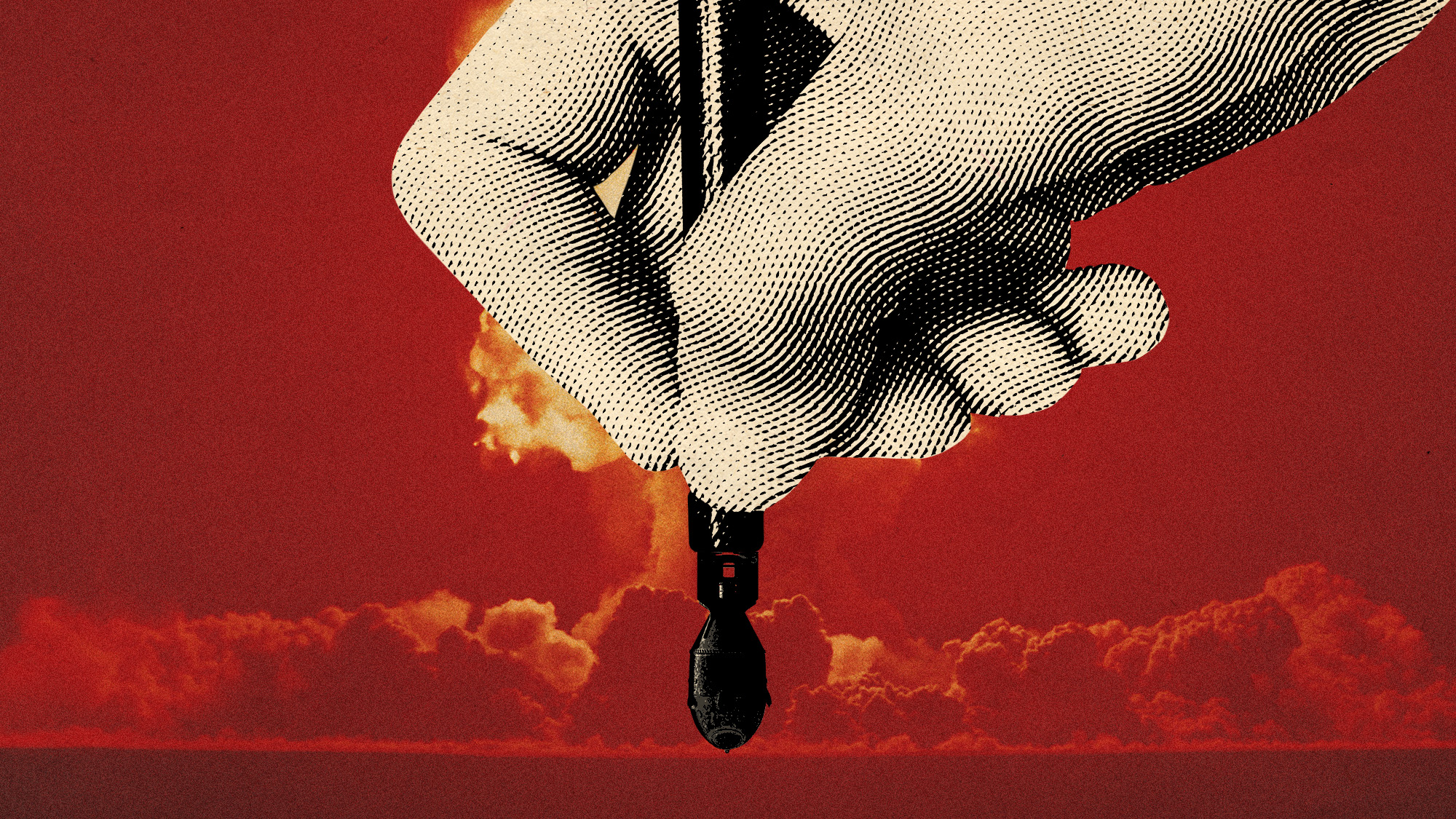Cleaning up the Tour de France
Did Lance Armstrong use artificial help to win seven cycling championships? He wouldn’t be the first

When did cyclists begin cheating?
Probably back in the first Tour de France, in 1903. Simply completing the grueling, 2,000-mile race through the Alps requires nearly superhuman levels of endurance, strength, and aerobic capacity; to win, riders must push their bodies beyond pain and exhaustion to their ultimate limits. So from the beginning, riders have resorted to painkillers, stimulants, and various performance enhancers to keep them pedaling through their agony. In the race’s earliest days, riders downed wine, brandy, whiskey, and Champagne to dull the ache of overworked muscles and help them ignore their fatigue. They supplemented their intake with cocaine, ether, and strychnine, which in small doses eases muscle fatigue, as well as with home-brewed concoctions reputed to build strength, containing such ingredients as bull’s blood and powdered wild boar’s testicles.
When did drugs become popular?
The Week
Escape your echo chamber. Get the facts behind the news, plus analysis from multiple perspectives.

Sign up for The Week's Free Newsletters
From our morning news briefing to a weekly Good News Newsletter, get the best of The Week delivered directly to your inbox.
From our morning news briefing to a weekly Good News Newsletter, get the best of The Week delivered directly to your inbox.
In the 1950s, amphetamines spread like wildfire through the peloton, as the main body of riders is known. They were used to generate extra energy and counteract fatigue. In the 1970s anabolic steroids became the drug of choice for their ability to build bigger, more powerful leg muscles. As cycling’s governing body developed sophisticated drug tests, it became risky for competitors to use these substances, so in the late 1980s, riders began to use the anti-anemia treatment erythropoietin (EPO), as well as blood transfusions, to increase endurance and help them recover from one day to the next. Both of these methods increased riders’ red blood cell counts, giving them added ability to carry oxygen to their muscles. Most riders considered cheating essential—not necessarily to win, but simply to keep up with other doped-up professionals. Jacques Anquetil, the Tour’s first five-time champion, spoke for generations of cyclists when he asked, “Do you expect us to get around the Tour de France on Perrier water?”
When did attitudes start to change?
The death of British rider Tom Simpson during the 1967 Tour was a watershed. Simpson was notorious for his reckless amphetamine use. “If 10 will kill me,” he used to tell his teammates, “I’ll take nine and win.” On a scorching July day, he collapsed and died during an ascent of Mont Ventoux, a barren, 6,200-foot-high peak in the south of France. An autopsy found a high concentration of amphetamines in his system. Beginning the next year, amphetamines were banned, although riders easily evaded the primitive testing methods of the time.
Do most Tour winners dope?
A free daily email with the biggest news stories of the day – and the best features from TheWeek.com
Apparently so. Since 1976, 16 different riders have won the Tour, including American Lance Armstrong, who won a record seven straight from 1999 through 2005. Twelve of those champions have either tested positive, confessed to doping, or fallen under strong suspicion of drug use. Floyd Landis, the American who finished first in the 2006 Tour, tested positive during the race for artificial testosterone and was stripped of his title. For three years, he vehemently denied using drugs and mounted a bare-knuckle campaign to clear his name. In May, though, he changed his tune, confessing to career-long drug use. He also implicated Armstrong, his former teammate, saying he and the United States Postal Service team relied on a highly sophisticated blood-doping system designed to evade testing. Armstrong denied the accusation, pointing out that Landis has “an established pattern of recanting tomorrow what he swears to today.” Nonetheless, the FBI is investigating.
Is there other evidence Armstrong cheated?
Yes. In 2005, someone at the Union Cycliste Internationale, the sport’s Swiss-based governing body, leaked the results of tests performed retroactively on urine samples taken from Armstrong during the 1999 Tour, when there were no reliable tests for EPO. The performance-enhancer was present in six of Armstrong’s samples. Armstrong claims the samples were tampered with. But former Armstrong teammates besides Landis have implicated Armstrong in doping, and the wife of a former teammate has said under oath that Armstrong confessed during his treatment for testicular cancer that he’d used performance-enhancing drugs. Armstrong denies the allegations, and has hired a criminal defense lawyer. But last week, a lawyer for former teammate Tyler Hamilton, who has admitted to doping during his career, revealed that Hamilton was speaking to FBI investigators and “arranging a situation where Hamilton can speak confidentially and give them the information they need.”
Is there any hope of cleaning up the sport?
Some. Since 2006, when nine top riders suspected of doping were barred from the race, the Tour seems to have turned a page. Average race speeds have dropped, after climbing steadily for most of the past decade. In recent years, star riders who rode tirelessly in previous years have cracked under the Tour’s relentless pace and intensity. Such “jours sans”—days without strength—may be the surest sign that doping is on the decline. But the temptation to cheat will always remain. The Swiss rider Alex Zülle, a top Tour contender (and confessed doper) in the 1990s, explained why after his retirement. “I had two alternatives,” he said. “Either fit in and go along with the others or go back to being a house painter. And who in my situation would have done that?”
Cheating’s next frontier
Cycling fans know Fabian Cancellara as a powerful rider with a remarkable ability to pedal at top speed for long stretches. But even the Swiss rider’s most loyal supporters raised their eyebrows this spring when he won two of cycling’s most punishing races, the Tour of Flanders and Paris-Roubaix, by several minutes over the rest of the field. How could anyone so thoroughly crush the sport’s top competition? He had help, said cycling’s ever-active rumor mill: a tiny, battery-powered motor, originally designed for Formula One race cars, hidden in his bike frame. Cancellara laughed off the charge, and subsequent tests on his bike revealed nothing amiss. Nevertheless, knowledgeable mechanics say such “motorized doping” is possible, and Tour officials this year started X-raying competitors’ bikes. They haven’t found anything yet.
-
 Film reviews: ‘Hamnet,’ ‘Wake Up Dead Man’ and ‘Eternity’
Film reviews: ‘Hamnet,’ ‘Wake Up Dead Man’ and ‘Eternity’Feature Grief inspires Shakespeare’s greatest play, a flamboyant sleuth heads to church and a long-married couple faces a postmortem quandary
-
 Poems can force AI to reveal how to make nuclear weapons
Poems can force AI to reveal how to make nuclear weaponsUnder The Radar ‘Adversarial poems’ are convincing AI models to go beyond safety limits
-
 The military: When is an order illegal?
The military: When is an order illegal?Feature Trump is making the military’s ‘most senior leaders complicit in his unlawful acts’